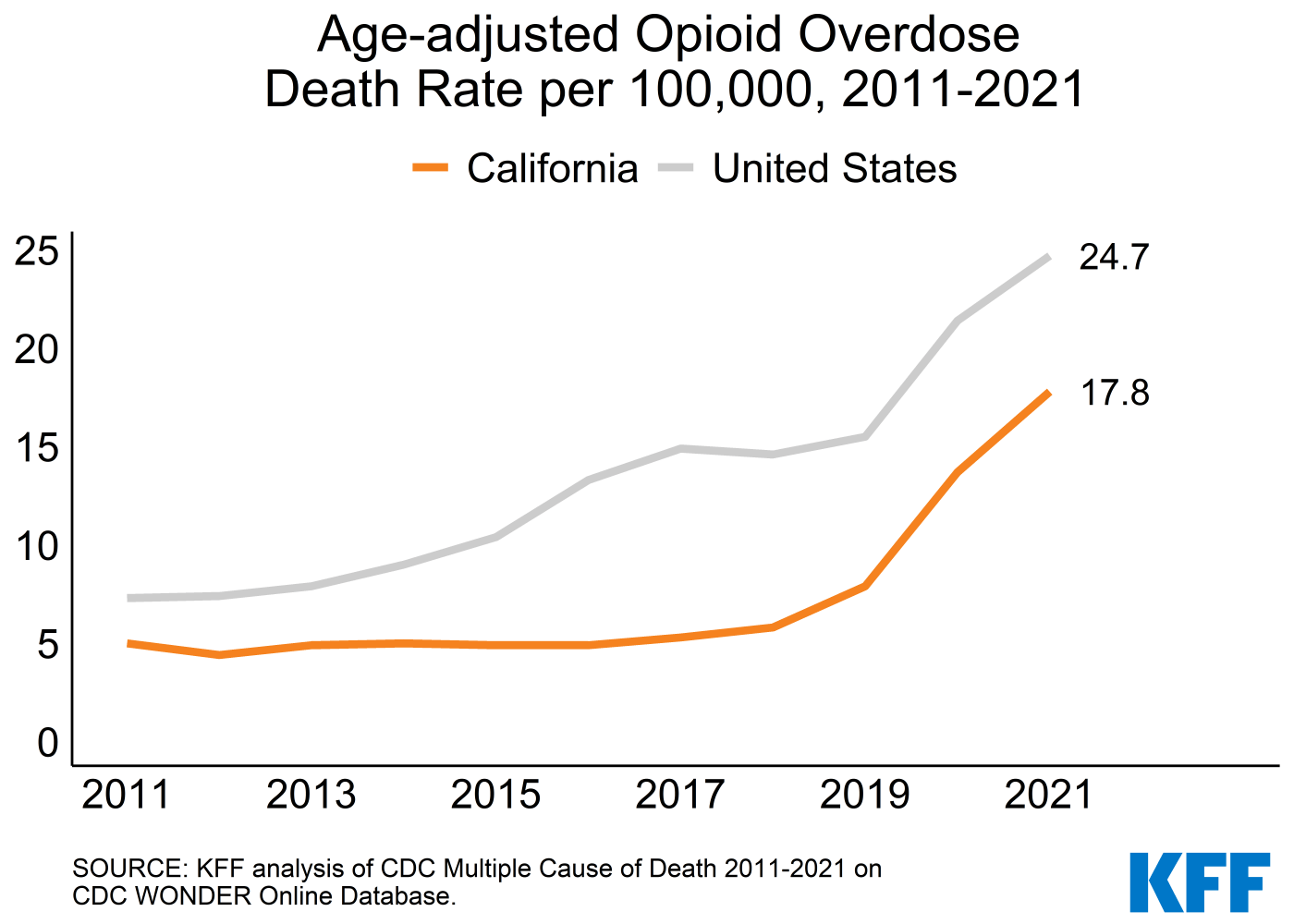During the first year of the COVID-19 pandemic, drug overdose deaths skyrocketed in the United States, increasing by 30.6%. Every state felt the impact, with forty states experiencing significant increases in drug overdose death rates from 2019 to 2020. Smaller states reported relative increases. For example, Connecticut’s toll increased by 12.9% (from 34.7 deaths per 100,000 people in 2019 to 39.1 deaths in 2020). Mississippi reported the most significant increase, 54.8% (from 13.6 deaths per 100,000 people in 2019 to 21.2 deaths in 2020).
Between 2019 and 2021, California’s opioid-related deaths rose 121%, according to the California Health Department. Most of these deaths were linked to fentanyl, a potent and dangerous synthetic opioid.
In fact, many of the deaths throughout the United States were due to synthetic opioids, specifically fentanyl, the use of which increased more than 50% from 2019 to 2020. Fentanyl has grown rapidly within the illegal drug trade over the last decade, becoming a significant revenue source for domestic and international drug traffickers. It’s often mixed with other drugs like cocaine and heroin and surfaces in counterfeit versions of opioid prescription pills like OxyContin.
This article delves into the opioid crisis, focusing on the state of California. It examines the extent of the opioid problem in the state, explores the role fentanyl plays in this epidemic, and explains the measures Californians are taking to combat this crisis.
California’s Overdose Rates by County
Opioid overdoses and deaths have affected every city and town in California. The rural north-coastal counties of Del Norte, Humboldt, Lake, and Mendocino are experiencing the highest rates of opioid-related deaths. Of course, the most populous counties experience the highest number of deaths from opioids. Consequently, these counties also receive the most significant amount of the $200 million in opioid settlement funds distributed to California’s local governments. Note that this money is separate from the millions of dollars these counties receive and spend by the state. Los Angeles, San Diego, Riverside, and Orange County hold the highest number of California’s opioid deaths and have received 48.5% of the opioid settlement funds distributed throughout the state.
California’s Overdose Rates by City
Per the Orange County Healthcare Agency, the table below lists the number of opioid-related deaths in Orange County (by city) from 2019 to 2021. The total number of deaths in the county was 1,512.
San Juan Capistrano 29
Costa Mesa 83
Huntington Beach 143
Los Alamitos 8
Laguna Niguel 43
Newport Beach 54
Santa Ana 184
San Clemente 38
Dana Point 19
Placentia 29
Anaheim 189
Fullerton 77
Laguna Beach 12
Mission Viejo 48
Tustin 41
Westminster 45
Lake Forest 40
Rancho Santa Margarita 22
Fountain Valley 24
Orange 54
Yorba Linda 26
Cypress 19
Seal Beach 9
Laguna Hills 11
Garden Grove 60
Aliso Viejo 18
Villa Park 2
Brea 16
Laguna Woods 6
Stanton 12
La Habra 17
Buena Park 22
Unknown 30
Irvine 61
La Palma 3
Because fentanyl is responsible for many of these deaths, it’s given Californians cause to stop and examine fentanyl, specifically among the other opioids.
Why Fentanyl Is Known and the Killer Opioid
Pharmaceutical fentanyl has been used for decades to treat severe pain, particularly after surgery. However, a cheaper synthetic version of fentanyl has entered the illicit drug market. Its misuse has spread throughout larger cities, suburban neighborhoods, and rural communities. Because it’s manufactured illegally, the potency, which is up to 50 times stronger than heroin and 100 times stronger than morphine, varies dangerously.
In addition, the drug often finds its way into counterfeit prescription pills and party drugs. Users don’t know that their drugs are laced with fentanyl. It’s also often mixed with another drug called xylazine, known as “tranq,” which is a powerful sedative used in veterinary medicine. It is impossible to know when a drug is tainted with fentanyl.
Fentanyl comes in liquid or powder form or pressed into what looks like a prescription pill. Due to the potency, even a small amount can be lethal. During an overdose, a person’s breathing slows or stops altogether. For these reasons, fentanyl has become known as the “killer opioid.”
Health experts and harm reduction advocates are pushing for the broader distribution of fentanyl test strips, which help users detect fentanyl in their supply. Some states ban these test strips, believing they encourage drug use. However, California promotes them and even distributes them for free.
Impact of Fentanyl in California
Fentanyl-related deaths began to rise around 2019. In 2021-2022, 5,942 Californians died after ingesting synthetic fentanyl. That figure is nearly 86% of all opioid-related deaths in the state. During the same time, 21,000 emergency room visits were related to opioids and a third of those involved fentanyl. Alarmingly, more people died from fentanyl overdoses in California than from car accidents. Of those, men, Black and Native American Californians, and individuals 30 to 34 years old are disproportionately dying from the drug.
In 2023, 6,959 people died from an opioid overdose — a 115% increase from 2019. Again, most of those deaths were linked to fentanyl specifically.
How California Is Combating the Opioid Crisis
In response to the rising death rate, California lawmakers are attempting to pass legislation directing funds toward opioid treatment and prevention. Governor Gavin Newsom’s administration has allocated more than $1 billion in the fight against the opioid epidemic. Much of the money comes from federal funds for treatment, prevention, and recovery services. In addition to that, California has allocated $416 million from its general fund, which funds medication-assisted treatments for people with opioid disorders. Some funds also go toward the purchase of naloxone.
Additional funds, totaling about $133 million, come from opioid manufacturers, distributors, and consulting firms as part of settlements. They are paying due to their participation in driving the prescription opioid crisis. Settlement funds are intended for specific purposes, such as substance use disorder training for clinicians, fentanyl education programs for children, naloxone distribution, and overdose data collection.
Naloxone Distribution
Naloxone is a life-saving medication that reverses an opioid overdose, including prescription opioids, heroin, and fentanyl. Naloxone can be given quickly through a nasal spray (Narcan®) or an injection into the outer thigh or other major muscle. Naloxone is safe and easy to administer, works immediately, and is not addictive. Naloxone has few adverse side effects and has no effect if administered to someone with no opioids in their system.
California’s Department of Health Care Services (DHCS) created the Naloxone Distribution Project (NDP) to combat opioid overdose-related deaths in California. The NDP receives State General Funds from the state and opioid settlement funds from the Janssen and Distributors (J&D) Settlement Agreements.
The NDP’s goal is to reduce opioid overdose deaths by providing free naloxone to community entities such as police departments, county jails, and probation centers; fire, EMS, and first responders; universities, and schools; tribal entities; and public health and behavioral health departments. They also provide it to community organizations like harm reduction groups and opioid coalitions.
Fentanyl Test Strips (FTS)
The use of FTS is a harm reduction strategy that reduces the risk of fatal and nonfatal overdose of fentanyl. Test strips enable people who use drugs to be safer because they aid in reducing drug use, encourage the use of the overdose-reversing medication naloxone, and assist in helping others in case of accidental overdose. Anyone can purchase FTS to test for the fentanyl in a drug. Fentanyl test strips cost about $1.00 each and can be purchased from various vendors. Free or low-cost FTS are available through syringe services programs (SSPs) via the California Harm Reduction Supplies Clearinghouse in California.
Proposed Legislation
The Governor and Attorney General Rob Bonta called upon the California Highway Patrol, California National Guard, and the State Department of Justice to crack down on fentanyl dealers in San Francisco. Fatal overdoses there have increased by over 40% within the first quarter of 2023.
This has been criticized as a law enforcement approach to a public health matter, which has led to much debate over how or whether to stiffen punishments for drug traffickers, many of whom also use fentanyl.
California lawmakers recently introduced new fentanyl-related bills. Republicans, Democrats, and law enforcement leaders pushed for harsher penalties for fentanyl possession and dealing. However, many of those bills were weakened or failed to pass during the legislative process. One proposed bill would have sent dealers to jail for up to nine years for selling fentanyl on a social media platform. Another bill proposed charging dealers with murder if someone dies taking their drugs.
Democrats and other advocacy groups are reluctant to support stricter penalties for fear of creating the same complications that arose from the national war on drugs and the subsequent disproportionate criminalization of Black people.
One law that passed requires California State University and community colleges to provide fentanyl test strips to students. Another law involves requiring concert venues and amusement parks to keep the overdose antidote naloxone on hand. Last year, the Governor announced that California would manufacture its own naloxone as part of the CalRx initiative.
Another pair of bills are set to increase punishments for dealers with large volumes of fentanyl and dealers who carry a gun.
Treating Addiction in Prison
In 2019, California prisons reached the highest rate of overdose deaths for a state prison system nationwide. In response, state lawmakers approved a far-reaching plan for substance abuse treatment in prisons.
Today, California is one of only a few states with a comprehensive treatment program within its prison system. This initiative has significantly reduced overdose deaths. The program is expensive, having a budget of $283 million for 2023. California was the first state to gain permission from the Biden administration to use Medicaid for healthcare in correctional facilities. This permitted the use of federal funds to cover opioid treatment.
At Valley State Prison in Chowchilla, California, inmates are screened for substance use when they enter, allowing staff to prescribe buprenorphine early in a prisoner’s sentence. At Valley State Prison, addiction treatment also includes group behavioral therapy.
Without treatment, inmates are at risk for recidivism once free. They are also vulnerable to overdosing shortly after their release because their tolerance for opioids, especially fentanyl, is weaker. At Valley State and other prisons in California, released inmates are offered naloxone, and those in treatment for opioid addiction also receive a supply of buprenorphine. This provides continuity of healthcare for inmates as they transition back into society.
How Drug Rehab Centers are Addressing the Opioid Issue
California has exceptional rehab centers offering drug and alcohol rehabilitation and detox services. People can find quality rehabilitation centers throughout Orange County. You’ll find many facilities if you are searching for a Laguna Hills rehab center, one in Laguna Woods, specifically Anaheim, or any other city in Orange County. Most take all the major insurance plans, including Medicaid, or offer a sliding scale for the uninsured. In addition to drug treatment therapy and detox services, many rehab centers administer naloxone and other medications at little or no charge.
As rehab centers fill to capacity, citizens understand there is a need to establish more centers throughout the state to serve those in need. However, some communities are challenged with finding appropriate locations for these centers, especially those that dispense medicines and fentanyl test strips. Residents fear that such services will draw undesirable drug seekers to their neighborhoods and marketplaces.
A Long Road Ahead for Californians
Despite all the state’s efforts to reduce opioid overdose deaths, public health policy experts assert there are no clear solutions. Drug policy experts have lauded California for making naloxone commonly available, but they also stress the importance of continuing to fund drug treatment programs in jails and prisons. They also support the use of anti-addiction medication in any treatment program.
When it comes to legislation, lawmakers should not overlook the underlying causes of addiction.
While drug traffickers need to be prosecuted, it’s worth reviewing the effectiveness of increased penalties for people who are acting under the influence of their addictions. It’s been suggested that lawmakers could and should include drug treatment programs in their sentencing, whether that be with incarceration or instead of it, depending on the nature of the crime. In the long run, offenders will have the opportunity to rehabilitate and, more importantly, receive the medical treatment they need to manage their addiction. The result will be fewer deaths and fewer people incarcerated for repeat offenses.
Another option is for California to permit another harm-reduction strategy, supervised consumption sites. There, opioid users could legally use drugs, with the goal being to ease people into treatment.
In summary, opioids, and the use of fentanyl specifically, have changed the drug landscape permanently. California and all the states must remain vigilant in their efforts to combat the rising number of overdose deaths in the United States.







